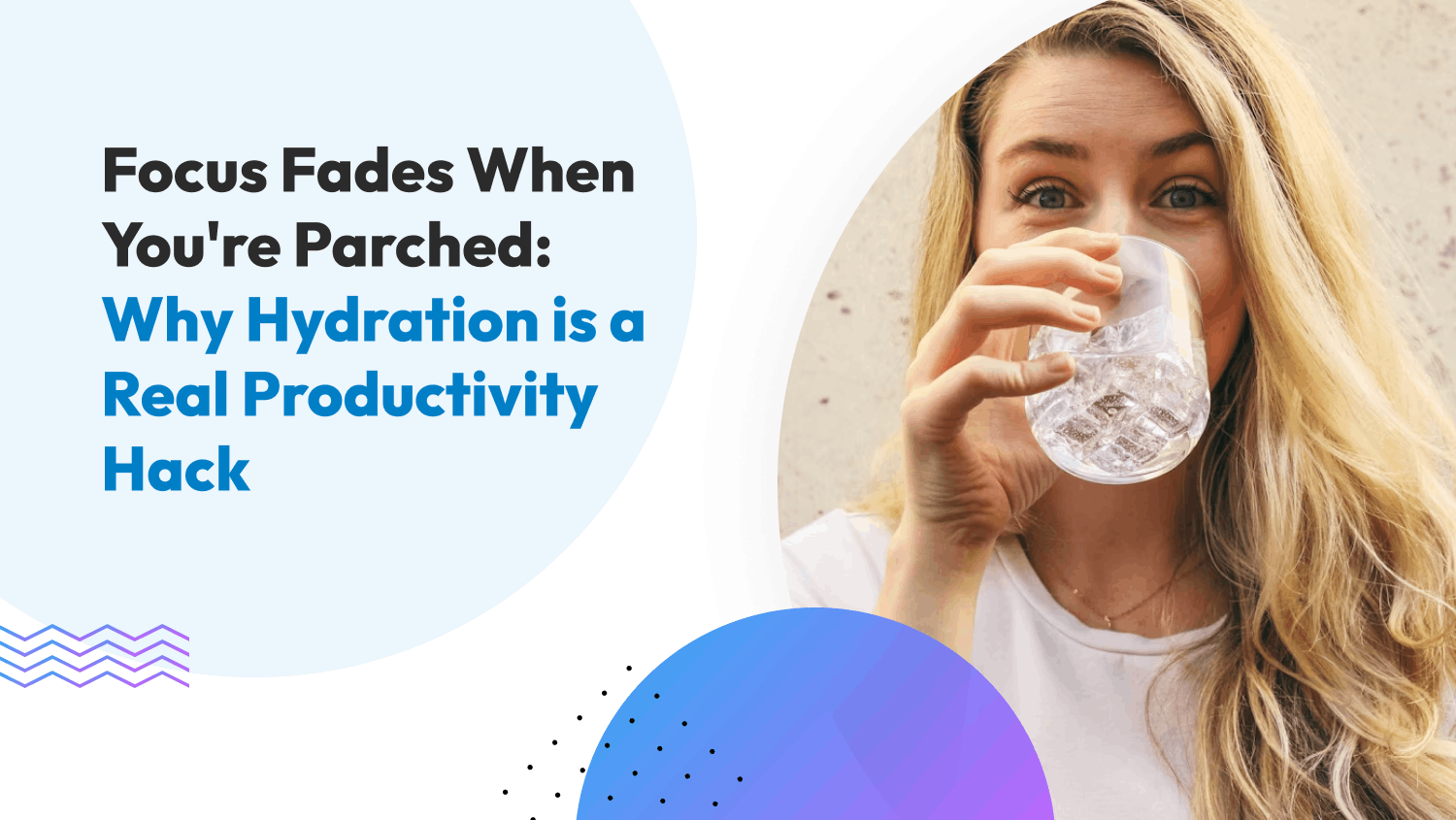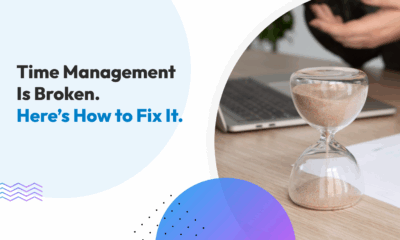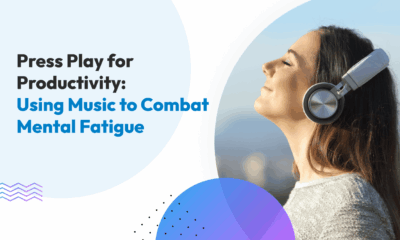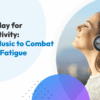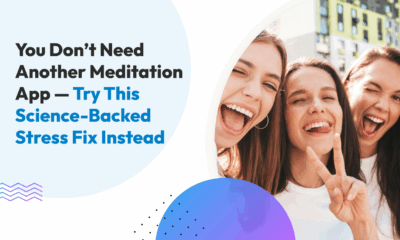Science Says
Focus Fades When You’re Parched: Why Hydration is a Real Productivity Hack
Let me tell you about the time I worked for 4 hours straight, fueled only by coffee and sheer hyperfocus. By the time I emerged from my work cave, I was completely crashed – brain fog so thick I could barely think, desperately needing a nap, and basically done for the day. It took me way too long to connect the dots that I’d had nothing but coffee since morning. Zero water. My body was basically running on fumes.
Here’s the thing: I’m neurodivergent, which means I ping-pong between distraction and hyperfocus. And when I’m in the zone, the world could be ending and I wouldn’t notice, let alone remember to drink water.
If you’re the type to get so wrapped up creating content or jumping from meeting to meeting that you end up with a raging headache before taking your first sip of water for the day, I see you. I WAS you. And while yes, I’ve become that person with the millennial emotional support water bottle (not sorry!), there’s actual science behind why staying hydrated matters for our productivity.
Recent research in the American Journal of Human Biology tracked 78 older adults for three months, measuring their hydration levels and putting them through mental acuity tests. What they found validates what my crash-and-burn days taught me the hard way.
Note: This article is for informational purposes only and isn’t medical advice. Always consult your healthcare provider before making changes to your nutrition or hydration routines.
Dehydration Is More Common Than You Think (Even at Your Desk)
Forget the stereotype of dehydration as something that happens only to athletes, hikers, or people working outdoors on hot summer days. In this study of adults going about their normal routines with no heat exposure, excessive exercise, or deliberate water restriction, about one in three participants was dehydrated at any given visit.
To measure hydration, researchers used Serum osmolality (Sosm), basically a lab test that measures the concentration of dissolved particles in your blood. It’s way more reliable than checking your pee color or trying to remember how many glasses you’ve had (trust me, I tried the counting method and it doesn’t work when you can’t remember if you’re on glass #2 or #5).
What makes Sosm particularly useful is that it shows your longer-term hydration status, not just whether you chugged a glass of water five minutes ago.
Don’t assume you’re hydrated simply because you don’t feel parched. I learned this one the hard way after too many afternoon crashes. Now I keep a ridiculous gallon jug with time markers on it (yes, really) because I finally accepted that I couldn’t trust my instincts to drink water regularly.
For my fellow entrepreneurs who struggle with this: integrate hydration into your existing systems. Schedule it like you would meetings. If you manage a team, normalize water bottles on desks and hydration reminders during check-ins. Make it part of the culture, not an afterthought.
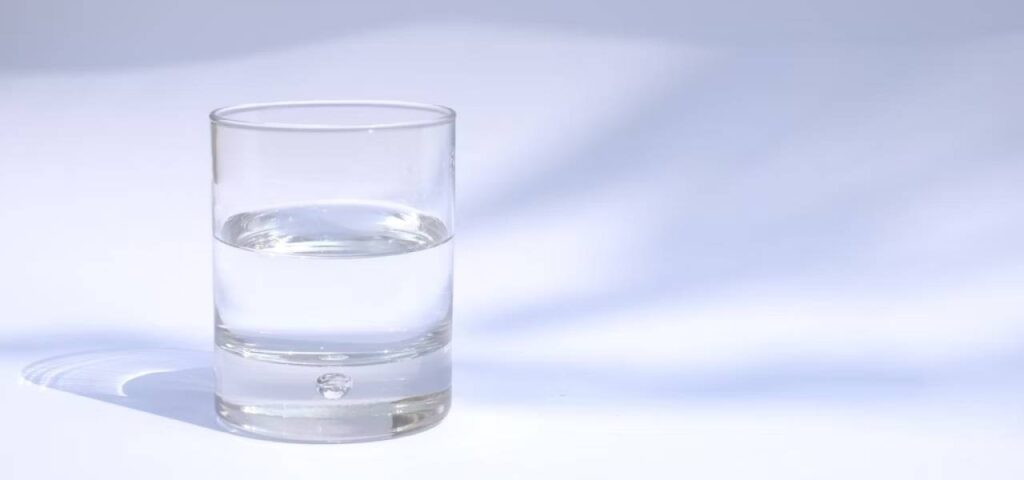
Your Thirst Mechanism Is Basically Useless
Here’s what really got me about this research: The thirst mechanism doesn’t kick in until you’re already about 1% dehydrated. And a study by Wittbrodt & Millard-Stafford found that even at just 2% dehydration, your attention, executive functioning, and motor coordination start taking hits.
This adaptive mechanism helped our ancestors wander farther from water sources, which is great for evolution but terrible for modern productivity. Most participants in the study maintained the same hydration levels across all three visits, suggesting we adapt to whatever level of water we regularly consume, even if it’s not enough.
I was definitely adapted to chronic mild dehydration for YEARS. I thought my afternoon brain fog was just normal. Spoiler: it wasn’t.
Build “hydration checkpoints” into your workflow rather than waiting for thirst. For example, drink water between each client call or every time you switch task themes. When I travel now, I use this little counter that attaches to my water bottle to track intake. Game changer.
The Age Factor (And Why It Matters Even If You’re Not 60)
The study focused on middle-to-older adults (average age 60.5) because they’re especially vulnerable. According to the research, older adults “exhibit reduced thirst thresholds and sensitivity to changes tied to hydration status.”
But here’s what I’ve noticed coaching clients for 10 years: this starts happening earlier than we think, especially for those of us with ADHD or who get into hyperfocus states. When you’re deeply focused, ALL body signals get muted, including thirst.
One in three participants was dehydrated, and this didn’t change over the three-month study. They were consistently, chronically under-hydrated.
If you’re thinking “I’m only 35, this doesn’t apply to me,” think again. Start building these systems now.
Not All Brain Functions Are Equal (This Explains So Much)
This is where it gets really interesting. The researchers tested four cognitive areas:
- Inhibition – controlling impulses and ignoring distractions
- Working Memory – juggling information in your head
- Cognitive Flexibility – adapting when rules change
- Sustained Attention – staying focused for extended periods
Here’s the kicker: dehydration ONLY affected sustained attention. The other skills were largely fine.
This perfectly explains my 4-hour-hyperfocus-coffee-crash disaster. Short tasks with breaks between them were no problem. But those long, deep work sessions we need for complex problem-solving or creative work are where dehydration shows up to ruin the party.
Before important presentations, long writing sessions, or anything requiring extended focus, I now prep by hydrating beforehand and keeping water within arm’s reach. It’s not about chugging a gallon right before (please don’t) but maintaining consistent hydration so your baseline supports deep work.
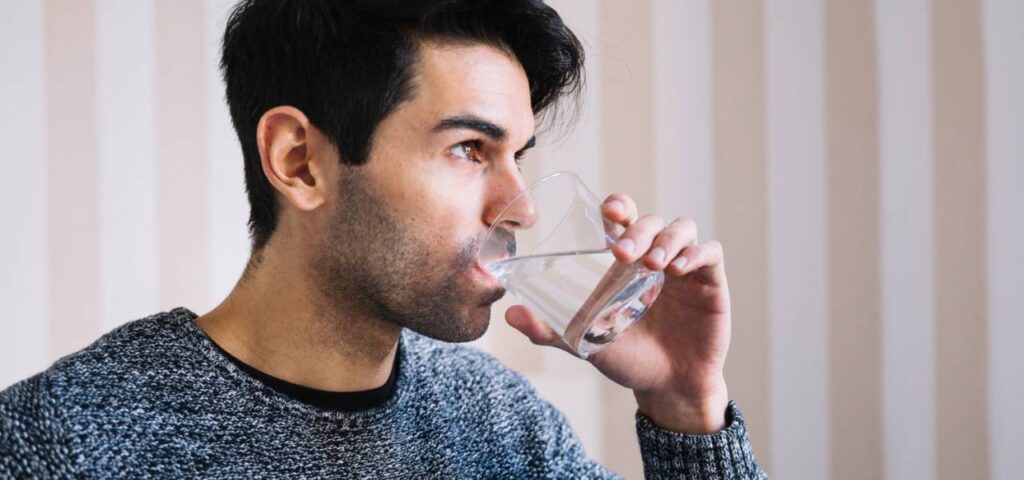
It’s Not Just Your Focus, It’s Your Mood Too
The study briefly mentioned that “dehydration negatively affects mood and increases irritability.” This tracks completely. How many times have you been cranky, impatient, or just DONE with everyone, only to realize you’ve been running on coffee and determination all day?
Your mood isn’t just about thoughts and feelings. It’s also about your physiological state. Just like being hangry is real, being thirsty-cranky is too.
If you notice yourself getting easily frustrated during the workday, take it as a cue to hydrate. I’ve started treating water breaks like I treat stretching for a stiff back: necessary maintenance, not optional.
Making Hydration Actually Happen (My Real System)
Look, I tried everything before landing on what works. Counting water bottles? Failed. I’d lose track by noon. Fancy apps? Ignored the notifications. Setting alarms? Snoozed them all.
What finally worked was accepting that I needed a system that didn’t rely on my memory or willpower. Enter: the ridiculous gallon jug that lives in my fridge with time markers on it. I know exactly how much I need to drink by when. No counting, no remembering, just checking if I’m at the 2 PM line yet.
I aim for a gallon a day, which yes, is more than strictly necessary for most people. But I work out a lot, and I’ve found that when I maintain this level, even dehydrating activities like wine tasting or coffee marathons don’t wreck me anymore. I bounce back fast because my baseline is solid. Scientific note here: The National Academy of Medicine recommends about 15.5 cups (3.7 liters) for men and 11.5 cups (2.7 liters) for women from all beverages and food sources, which is significantly less than a gallon (3.8 liters) of pure water.
My 80/20 rule: I’m happy if I hit my goal 80% of the time. Perfection isn’t the point. Consistency is.
For travel or leaving the house, I attach a little counter to my regular water bottle. Each click is one bottle down. Simple, foolproof, doesn’t require brain power.
The Environment Factor You’re Probably Ignoring
Even in climate-controlled environments, rising global temperatures and fluctuating humidity levels can increase your water needs. With more frequent heat waves and environmental stressors, subtle dehydration risk may be rising for everyone.
Working from home has been a hydration game-changer for me because I can keep that gallon jug in the fridge. But when I worked in offices or coffee shops, it was so much harder. Air conditioning and heating systems are secretly dehydrating, and we rarely account for that.
Monitor your environment and adjust accordingly. On hotter days or when indoor climate control is running hard, consciously increase your fluid intake. For my fellow digital nomads and frequent travelers: research the climate of new destinations and plan your hydration strategy before you arrive. Altitude and air travel are sneaky dehydration triggers too.
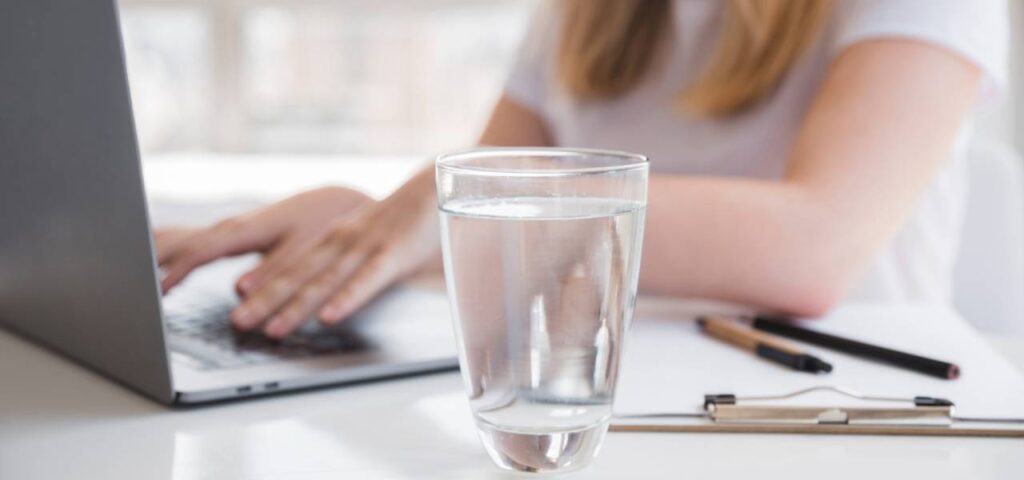
The Bottom Line: Your Brain Needs Water (Duh, But Also… Really)
This research confirms what my crash-and-burn days taught me: hydration isn’t just about physical health. It’s about being able to maintain the sustained attention we need for the deep work that actually moves our businesses forward.
Unlike complicated productivity hacks that require elaborate setups, drinking water is stupidly simple. The hard part is remembering to do it, especially when you’re someone who gets lost in work.
Not everyone needs a gallon a day. Start with something reasonable for you. Maybe it’s 64 ounces, maybe it’s more. The point is to have a target you can hit 80% of the time and increase from there if needed. Your activity level, environment, and body will tell you what’s right.
Whether you embrace the emotional support water bottle life like me or find your own system, make hydration part of your productivity stack. Your future-focused self will thank you.
What’s your biggest hydration challenge? Is it the hyperfocus black hole? The “coffee counts as water, right?” rationalization? Or something else entirely? Let me know in the comments!
P.S. Yes, I really do carry a purse with a built-in water bottle holder and multiple pockets. My husband thinks it’s ridiculous but other hydration nerds stop me to ask about it all the time. Priorities, people. 😊
Limitations of This Study
While this research offers valuable insights, it is important to recognize several limitations.
Firstly, the study sample was predominantly white and drawn exclusively from the Pennsylvania area, which means the findings cannot be automatically generalized to people of other racial or ethnic backgrounds, or to those living in different regions—particularly individuals in communities where water insecurity is more common. Additionally, the study did not directly measure or control for environmental factors such as indoor and outdoor heat exposure, even though these are known to affect both hydration status and cognitive function.
The range of cognitive testing was also limited, as only four types of cognitive tasks were administered. These focused mainly on certain executive functions and attention, leaving out other important skills used in daily life, like long-term memory, spatial ability, and processing speed. The study design included three measurement points over three months, with a modest overall sample size, which may reduce the ability to detect subtle effects in the analyses of the relationship between hydration and cognition.
Dietary controls were somewhat limited; participants were instructed to avoid high-fat foods and caffeine on test mornings, but meal timing and content the previous day were not standardized. Because eating a large, rich meal can briefly alter hydration status, this introduces some variability. Furthermore, no participants were found to be overhydrated (with Sosm <275 mOsm/kg), so the study could not assess whether excess hydration might also negatively impact cognitive performance, even though some evidence suggests this can occur.
Lastly, some potential confounding factors—such as physical activity level and sleep—were not directly measured or controlled. Although the study’s within-participant design helps to reduce the impact of these unmeasured variables, it does not entirely remove their influence across all participants.


